Stabilization of Gravel Surfaces
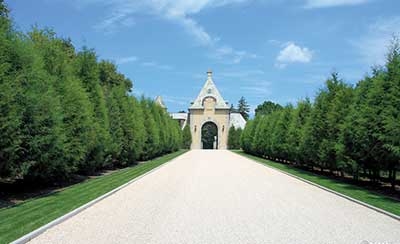 Stabilized Gravel Driveway
Stabilizing A Gravel Driveway:
Gravel driveways require more maintenance than your standard pavement types but offer unique benefits that pavement does not. Gravel driveways can be permeable and are more tolerant to freezing / thawing without damage unlike pavement surfaces. One of the main drawbacks of a gravel driveway are issues arising from rutting and gravel migration. These issues can be alleviated and sometimes completely eliminated by using a gravel stabilizing grid.
Driveway Compaction & Installation:
The layers beneath the top layer of gravel are what will provide your driveway's stability and support. Therefore, you must properly prepare the bed for the gravel. The best solution for a stable driveway will include digging 8 to 12 inches below the surface of the driveway, the removal of roots and other plants and then compact the soil with a plate compactor or roller to create the sub-base. Then, put down a 4-inch layer of coarse gravel on top of the compacted sub-grade layer. The top layer of gravel should be placed only after the sub-grade and sub-base are in place and compacted.
Stabilization Fabrics:
If your sub-grade was properly prepared but your driveway is deteriorating, you might want to place down a layer of geotextile
driveway fabric on top of the sub-grade layer and then place down the gravel. This fabric is an excellent solution for keeping your sub-base and surface gravel layers separated from the sub-grade level that will significantly reduce forming of potholes and ruts.
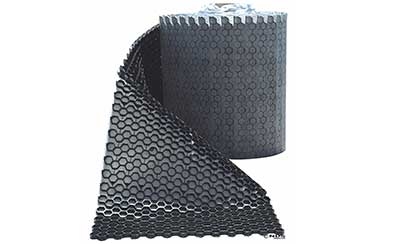
NDS EZ Roll Gravel Pavers
NDZ EZ Roll Gravel Pavers:
These gravel pavers decrease erosion while maintaining the look and functionality of gravel roads. They are made from 100% recycled materials and will minimize surface water runoff, providing an attractive, sustainable alternative to concrete and asphalt.
Recommended Uses for NDS EZ Roll Gravel Pavers:
Service roads, jogging tracks, golf cart paths, bike paths, truck and car wash areas, boat and RV parking and access and residential driveways. Other uses include; parking lots, roadway shoulders, fire lanes, emergency vehicle access road, equipment yards, truck maintenance yards, and construction entrance soil stabilizers.
Along with the above uses, EZ Roll Gravel Pavers are also an excellent alternative for erosion control on slopes and in swales.
Dupont GroundGrid
DuPont technology has been leading the industry for many years. DuPont Groundgrid is no exception, it is a geotextile grid that is used for ground stabilization for landscapes and construction projects. It has a three-dimensional honeycomb design which holds mineral infill to create a very solid surface. Just expand the three-dimensional honeycomb structure then place it on your project's surface and fill with gravel, sand, soil, or other materials to produce a strong, stable surface. Using DuPont technology, Groundgrid offers an unusually strong, stable surface for a job site.
DuPont Groundgrid is made from high-performance fabric created by the experts at DuPont. It's lightweight but also tough enough to last for decades in any condition. It is also extremely flexible and very easy to use. Performance-wise, it lets water flow in a horizontal direct through the structure to prevent water from building up around the pathway.
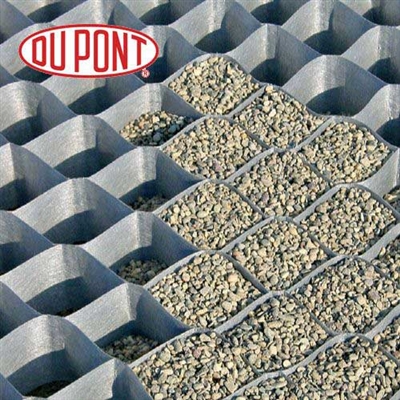
Dupont Ground Grid Gravel Stabilizer
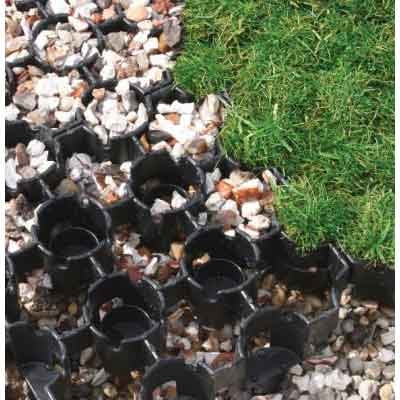 Dupont Ground Grid Gravel Stabilizer
TYPAR Bodpave 85 Gravel Pavers:
This is a ground-reinforcing paving grid system that is made from recycled HDPE plastic. TYPAR Bodpave 85 paving grids interlock with each other to produce a strong, stable surface that can handle heavy vehicle loads. The porous paving grids can be filled with gravel, grass or soil to create a gravel or natural grass surface.
Bodpave 85 Applications:
Regular traffic areas for both vehicles and pedestrians, overflow grass parking lots, golf cart paths, fire truck emergency lanes, wheelchair and handicap paths and grass driveways. It can be installed with a grass or gravel filled surface, depending on the requirements.
TYPAR Typave 25 Gravel Pavers:
Grass and gravel reinforcements are used for parking lots, fire access lanes, utility lanes, and emergency access lanes. You need to apply a reinforcement that is extremely durable and can withstand time. Typave 25 is the latest U.S manufactured, this porous paver is made from recycled plastic materials that meet LEED highest ratings. Leadership in Energy and Environmental Design is a certification program that focuses on new commercial building sites and has a rating system. This plastic paver is developed to deal with reinforced surfaces for H25 loading specs., while protecting grass surfaces. TYPAR Typave 25 Gravel Pavers are composed of Quick-Snap joints between the sections, providing a very strong structure that can be staked into the ground to prevent breaking or slipping.
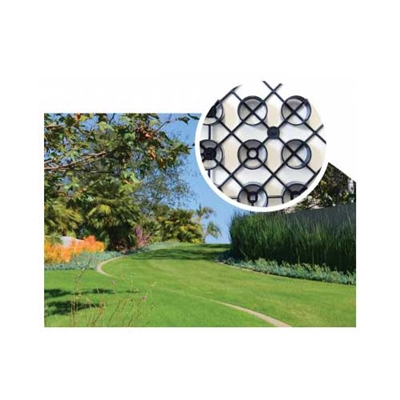 TYPAVE 25 Gravel / Grass Paver
Edge Restraints:
Edge restraints form a barrier along the edge of driveways keeping the gravel where it is supposed to be. You do not want a high-profile or edge along the sides, a slightly concave or humped concrete curb will reduce gravel traveling out of the driveway.
In Conclusion:
There are many products for driveways, paths, construction sites as well as for supporting heavy trucks and vehicles. With new technology, these products are also environmental friendly because it prevents materials ending up in landfills. Recycled materials are offering many great options for your all your ground projects. From fabric to plastic to pavers and edge restraints, technology will continue to make your project easier to complete while providing a long lasting finished product.
The Container Storage Yard Expansion In Long Beach
In August of 2006, Excel Paving was hired to stabilize the base for the Phase 3 container yard expansion by the Long Beach Harbor Department at the Pier T Marine Terminal of the Port of Long Beach. The expansion was in place for an area previously used as a drydock.
The Port of Long Beach container storage yard had been used on a daily basis by cranes, forklifts, container transport trucks heavily loaded down, and continuous non-stop traffic. Tight budgets and demanding soil conditions had caused engineers to re-think their options outside of standard rock fills.
The storage yard's subgrade was made up of dark grey sand silt. After a full on-site investigation, the engineers decided to use the EnvironGrid® EGA 208 material. The entire system was completed with a paved layer of concrete
In some sections, a biaxial geogrid was installed for greater stability and an 8 oz non-woven geotextile was placed in other sections that would be utilized by lighter traffic. EnviroGrid® was expanded out over the roll-out geosynthetics and then filled with a sand and rock mix.
Then the system was compacted and overfilled to offer a bond-breaking layer between the flexible stabilization system and the rigid pavement above. Initially, the contractors had a problem testing for compaction as the carbon black for UV stability in the EnvironGrid® caused problems with the standard compaction equipment. Upon switching to a Dynamic Core Penetrometer test or DCP, Excel Paving realized that the system was compacted better than expected.
EnviroGrid® was chosen to reduce the infill material needed as well as the ability to offer significant stability to the storage yard. Alternative options involved 200% to 300% more aggregate and at least double the amount of time to complete.
The port constantly experienced heavy traffic and the movement of multi-level storage areas. 10 years later, absolutely no care has been performed on the site and concrete-wearing surfaces looked the same as they did upon installation.
Stabilization of the Equipment Yard
Port Fourchon sits on the southernmost tip of Louisiana on the Gulf of Mexico. Dolphin Energy Equipment experienced enormous growth. Due to heavy equipment and supplies, the storage yard required an expansion of 1.5 acres to keep its operations running smoothly. With a water table two feet below the surface and a subgrade of low-grade sand, it was becoming difficult to expand. The facility needed a stable surface to handle the heavy equipment and supplies coming in.
The project was handled by the owner of Dolphin Energy Equipment by installing the EnviroGrid® system. The sand layer was compacted and a nonwoven geotextile was added as a separation layer along with geogrid for added reinforcement. EnviroGrid® was applied, filled, and compacted using high-quality limestone. The entire project was completed in less than 3 days by one man.
Because of the remote area, aggregate fill would cost $50 per delivered ton. The alternative to EnviroGrid®, aggregate fill was applied for a savings of $50,000. They continued to run high-volume, heavy-duty forklifts over the yard expansion even during major rain storms with no signs of rutting or disturbance to the surface.
Foundations for Buildings & Parking
In September 2018, Hurricane Florence damaged a lot of existing offices at the Cherry Point Marine Corps Air Station in North Carolina. Cherry Point had to install temporary offices in what was originally an open field. They chose a cellular confinement system to stabilize the parking lot and provide a sturdy base for temporary trailers.
As most of the offices were damaged by the hurricane, a temporary office was created out of open field space. The EnviroGrid® system was chosen for the parking lot to reduce the amount of maintenance upkeep while offering a durable foundation for the buildings.
Overview Of Construction
The entire system consisted of nonwoven geotextile fabric on top of the subgrade. The EnviroGrid® Geocell layer with an infill of crushed #57 stone. The cell had a depth equivalent to laying of crushed stone without EnviroGrid®.
The Results
The project took a crew of 5 men, and 2 weeks to install. The underlying fabric was laid with the EnviroGrid® Geocell placed on top of it. The cell was filled with #57 stone aggregate.
Pipe Yard Stabilization
Onshore Contracting was hired by a major offshore drilling company to stabilize their outdoor storage yard in Houma, LA which is southwest of New Orleans and near the Gulf of Mexico. The storage yard was sitting in a very low, marshy area with a water table less than 2 feet below the surface.
The storage yard was used to store and transfer steel pylons that weighed up to 250,000 lbs each. Very heavy-duty forklifts were required to move anything that large. With the combination of heavy equipment or material and poor subgrade, the objective was to find a way that could stabilize the subgrade and withstand the flow of traffic from heavy machinery.
Overview of Construction
Most of the organic materials were removed and the remaining subgrade was compacted. Excessive water was directed away from the site and nonwoven geotextile was installed to offer a separate layer. A biaxial grid was placed on top to offer additional reinforcement. The EnviroGrid® was deployed and filled with crushed recycled concrete. An additional of high-quality aggregate was used as a wearing surface for heavy equipment that would be on the rolling course.
The Results
EnviroGrid® Geocell was chosen to save installation time and cut the costs for infill material needed and for future maintenance. Alternative options would have required 200% to 300% additional aggregate and at least double the time to complete the installation. The storage yard had a high volume of 50,000 lbs forklifts moving material up to 5 times the weight of the forklift. Practically no rutting had been seen and the EnviroGrid® Geocell outperformed all expectations.
|